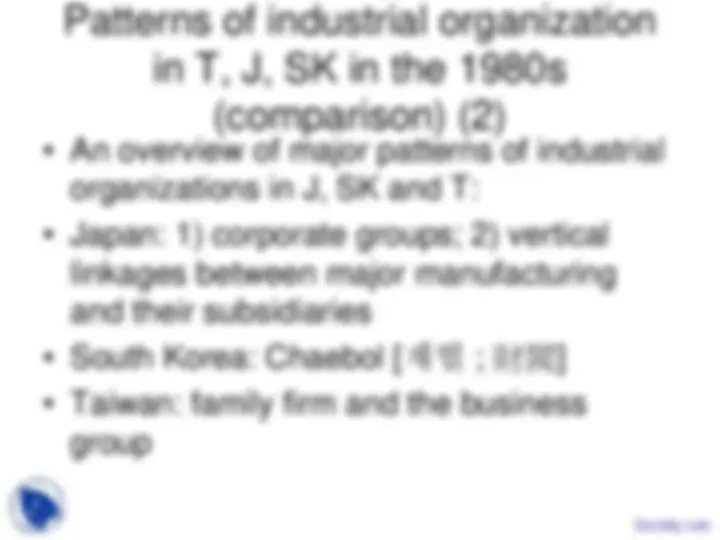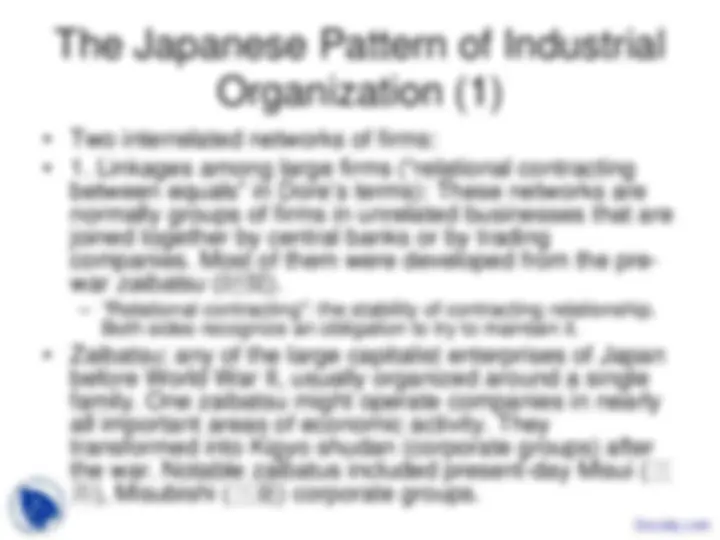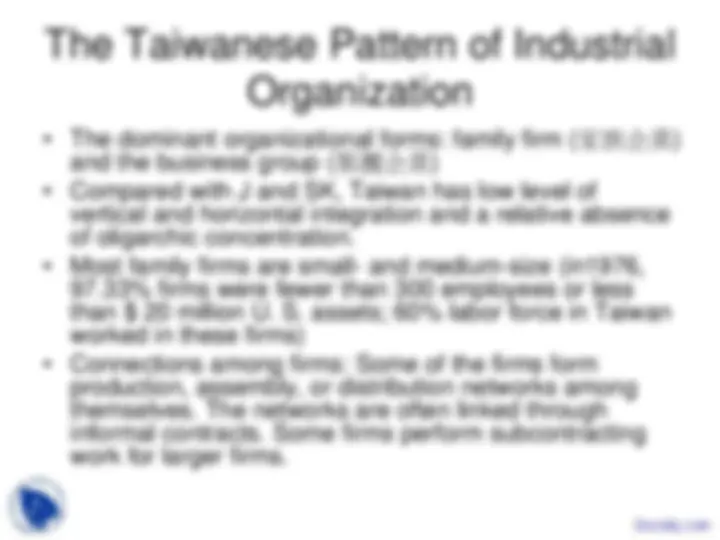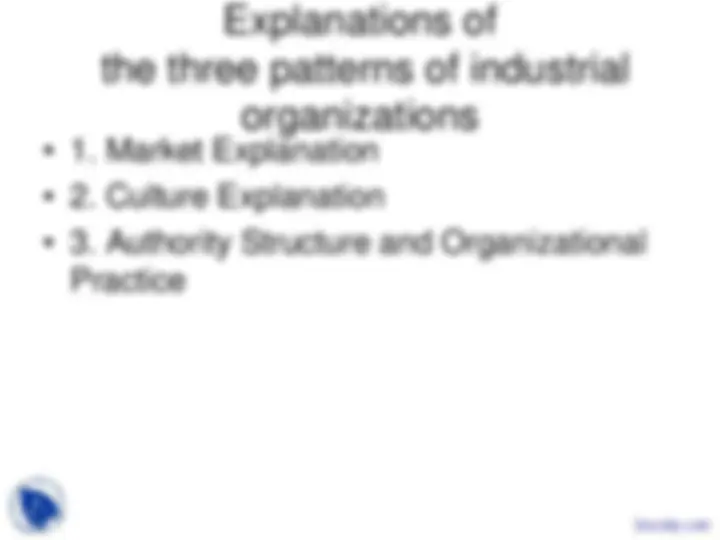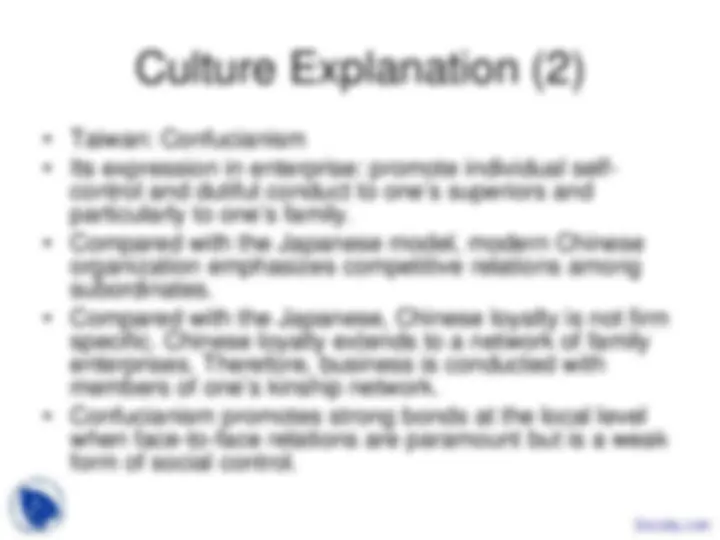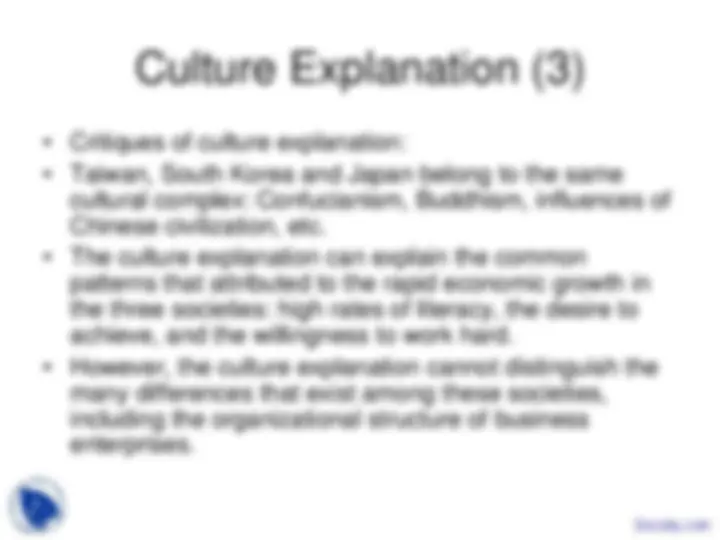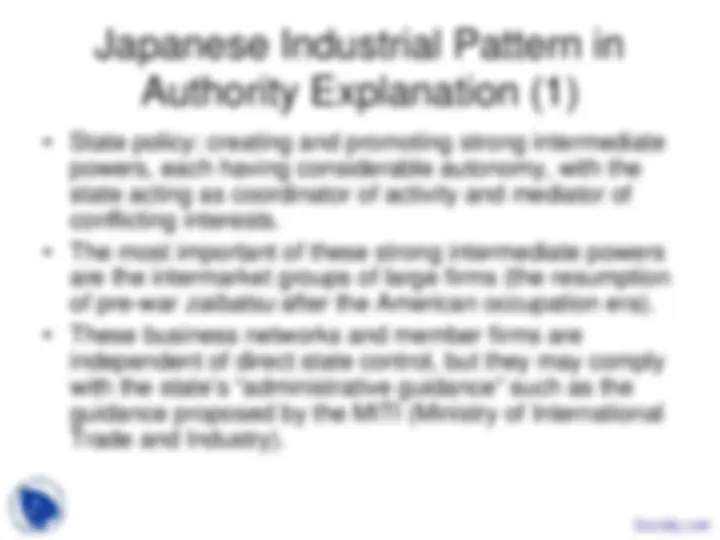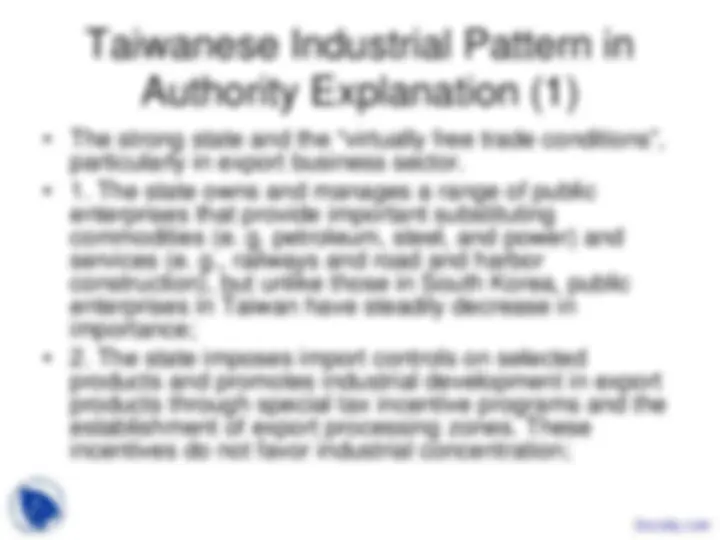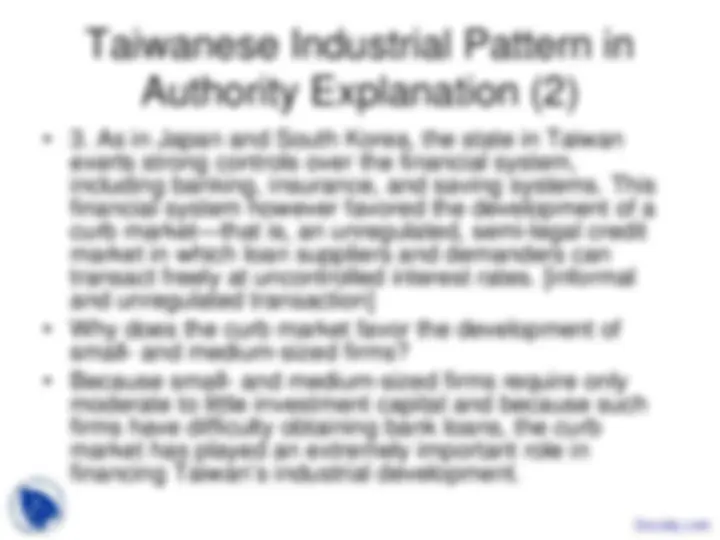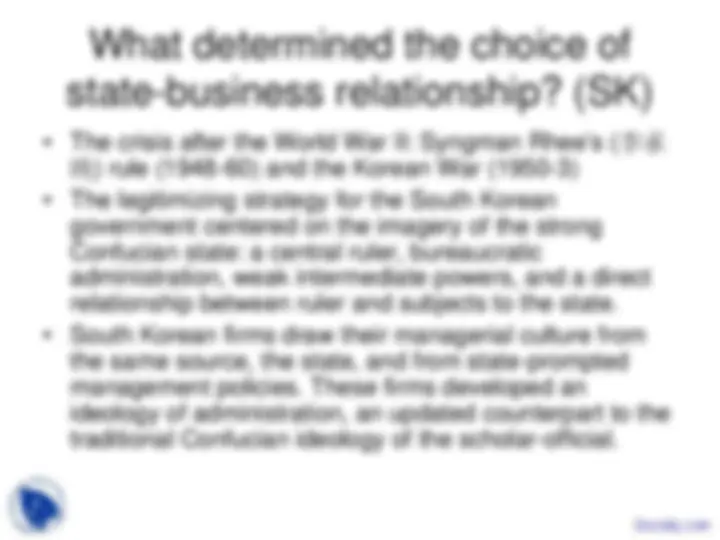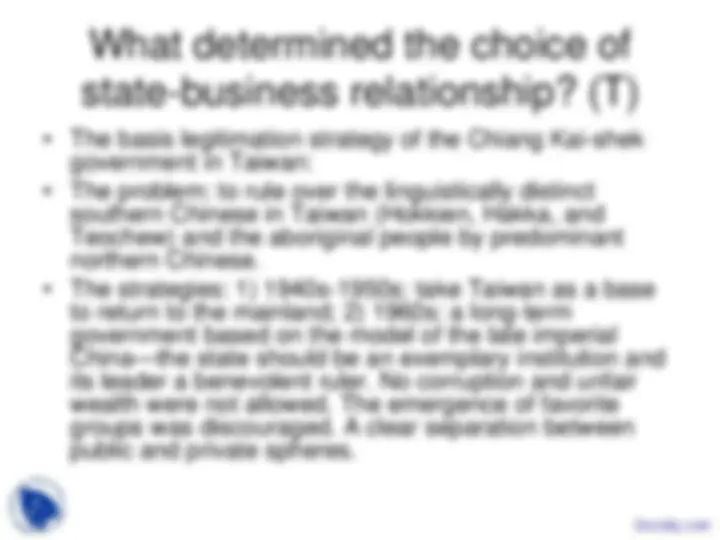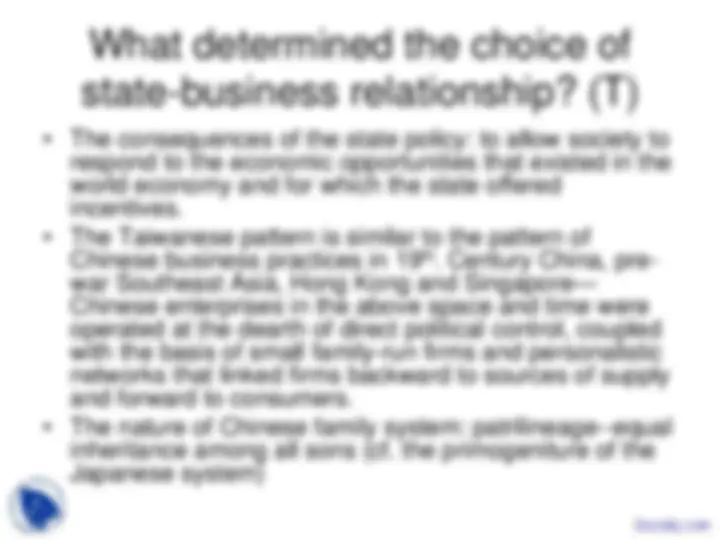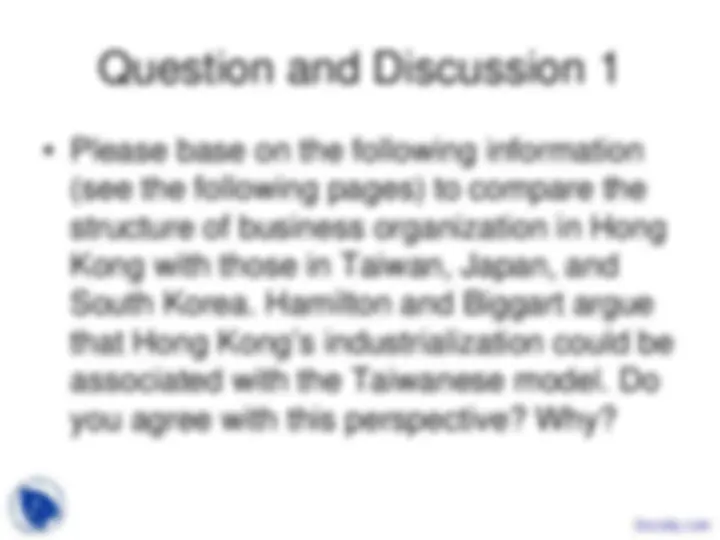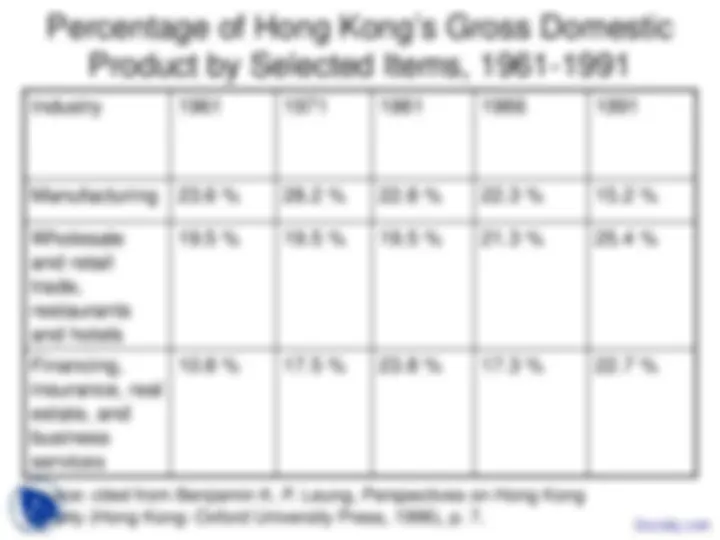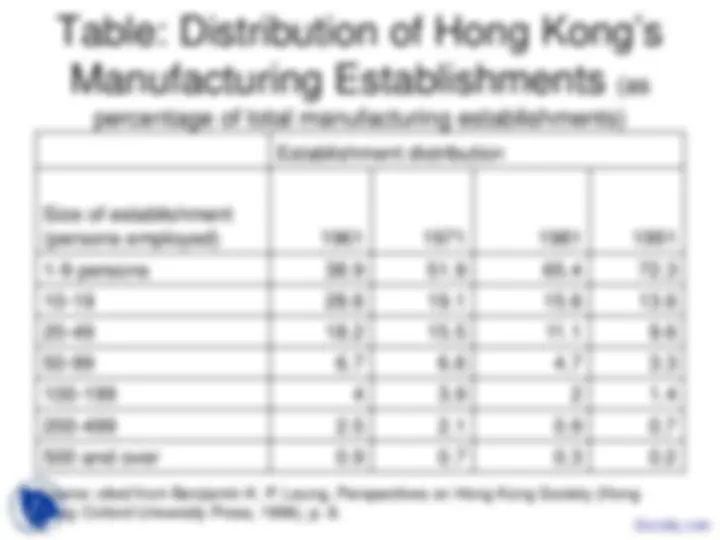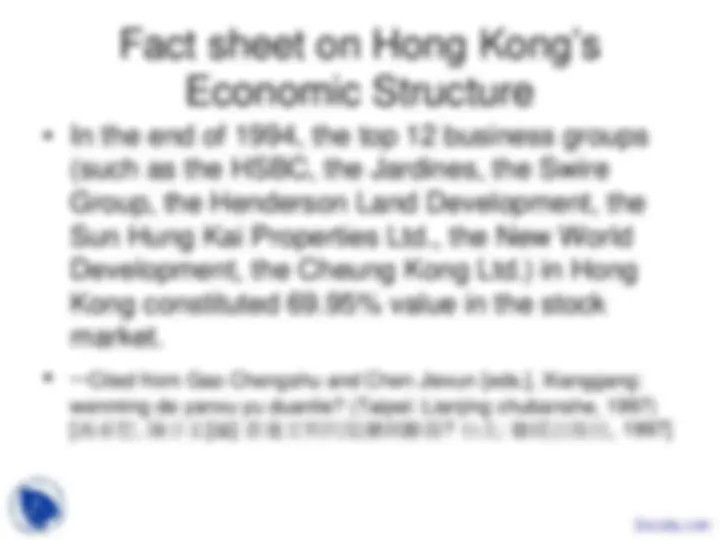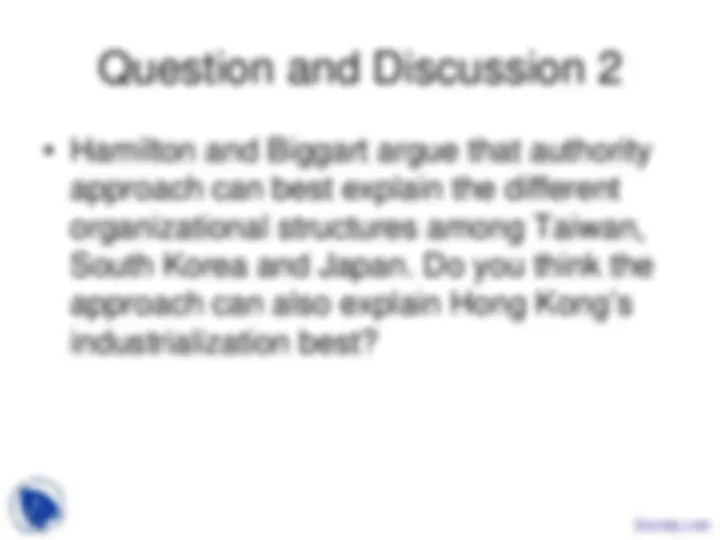Download Business Networks - Sociology in Economic Life - Lecture Slides and more Slides Economic Sociology in PDF only on Docsity!
Lecture Note 6
Business Networks
- Gary G. Hamilton and Nicole Woolsey
Biggart, 1988, “Market, Culture and
Authority: A Comparative Analysis of
Management and Organization in the Far
East”
- How can this article help us to better
understand Hong Kong’s post-war
state/business relationship?
Patterns of industrial organization
in T, J, SK in the 1980s
(comparison) (2)
- An overview of major patterns of industrial
organizations in J, SK and T:
- Japan: 1) corporate groups; 2) vertical
linkages between major manufacturing
and their subsidiaries
- South Korea: Chaebol [재벌 ; 財閥]
- Taiwan: family firm and the business
group
The Japanese Pattern of Industrial
Organization (1)
- Two interrelated networks of firms:
- Linkages among large firms (“relational contracting between equals” in Dore’s terms): These networks are normally groups of firms in unrelated businesses that are joined together by central banks or by trading companies. Most of them were developed from the pre- war zaibatsu (財閥).
- “Relational contracting”: the stability of contracting relationship. Both sides recognize an obligation to try to maintain it.
- Zaibatsu: any of the large capitalist enterprises of Japan before World War II, usually organized around a single family. One zaibatsu might operate companies in nearly all important areas of economic activity. They transformed into Kigyo shudan (corporate groups) after the war. Notable zaibatus included present-day Misui (三 井), Misubishi (三菱) corporate groups.
The South Korean Pattern of
Industrial Organization
- Chaebol: similar to the prewar zaibatsu in size and organizational structure. - In 1980-81: 26 chaebol controlled 456 firms - In 1985: 50 chaebol controlled 552 firms
- E. g. Samsung, Hyundai, Daewoo, Lucky-Goldstar
- Member firms of chaebol are closely controlled by central holding companies, which are owned by an individual or a family. The central holding companies of the chaebol do not have the independence of action (compared with the enterprise group possess in Japan).
- The central holding companies are managed by state.
- Outside the chaebol networks, few large and independent firms; no subcontracting between large and small firms.
The Taiwanese Pattern of Industrial
Organization
- The dominant organizational forms: family firm (家族企業) and the business group (集團企業)
- Compared with J and SK, Taiwan has low level of vertical and horizontal integration and a relative absence of oligarchic concentration.
- Most family firms are small- and medium-size (in1976, 97.33% firms were fewer than 300 employees or less than $ 20 million U. S. assets; 60% labor force in Taiwan worked in these firms)
- Connections among firms: Some of the firms form production, assembly, or distribution networks among themselves. The networks are often linked through informal contracts. Some firms perform subcontracting work for larger firms.
Market Explanation (1)
- All three economies fit the situation of technological advance as proposed by Chandler.
- internal and external transportation and communication systems are well developed;
- substantial and growing internal mass markets have risen and all have vast external markets;
- the most advanced technologies in the various industrial sectors are available.
- But the economies developed into three different forms of industrial organizations.
- Neither can the market explanation fully explain why the organizational structures of business enterprises in the three economies are so different
Market Explanation (2)
- The Japanese case: growing technology, expanding communication, and the increased volume of manufacturing transactions are not the causes of the development of Japanese zaibatsu. They developed simultaneously, if not earlier, than Japan’s industrialization in the Meiji era.
- The SK case: intervention of state into business organization can be traced back to pre-modern political practices.
- The Taiwan case: Only a few large organizations or concentrated industries. Even when a family business becomes successful, the pattern of investment is not to attempt to vertical integration in order to control the marketplace, but rather is to diversify by starting a series of unrelated firms that share neither account books or nor management.
Culture Explanation (2)
- Taiwan: Confucianism
- Its expression in enterprise: promote individual self- control and dutiful conduct to one’s superiors and particularly to one’s family.
- Compared with the Japanese model, modern Chinese organization emphasizes competitive relations among subordinates.
- Compared with the Japanese, Chinese loyalty is not firm specific. Chinese loyalty extends to a network of family enterprises. Therefore, business is conducted with members of one’s kinship network.
- Confucianism promotes strong bonds at the local level when face-to-face relations are paramount but is a weak form of social control.
Culture Explanation (3)
- Critiques of culture explanation:
- Taiwan, South Korea and Japan belong to the same
cultural complex: Confucianism, Buddhism, influences of Chinese civilization, etc.
- The culture explanation can explain the common
patterns that attributed to the rapid economic growth in the three societies: high rates of literacy, the desire to achieve, and the willingness to work hard.
- However, the culture explanation cannot distinguish the
many differences that exist among these societies, including the organizational structure of business enterprises.
South Korean Industrial Pattern in
Authority Explanation (1)
- Centralized state: the state is the leading actor that actively participates in the public and private spheres of economy—centralized economic planning and aggressive implementation procedures. These procedures aim at controlling the entire economy.
- The state controls the private sector through the control of the banking system, credit rationing, and other financial controls.
- A Korean firm should know how to follow along the state’s commands otherwise the firm would be subject to the following penalties, e.g. its tax returns might be subject to careful examination, or it application for bank credit would be ignored, or that its outstanding bank loans would not be renewed.
South Korean Industrial Pattern in
Authority Explanation (2)
- Medium and large firms, particularly the chaebol,
are favored by such planning and
implementation procedures, because state
policies support business concentration.
- However, these firms are also constrained by
government-controlled credit, by government
regulation of the purchase of raw materials and
energy, and by government price-setting policies
for selected commodities.
Taiwanese Industrial Pattern in
Authority Explanation (1)
- The strong state and the “virtually free trade conditions”, particularly in export business sector.
- The state owns and manages a range of public enterprises that provide important substituting commodities (e. g. petroleum, steel, and power) and services (e. g., railways and road and harbor construction), but unlike those in South Korea, public enterprises in Taiwan have steadily decrease in importance;
- The state imposes import controls on selected products and promotes industrial development in export products through special tax incentive programs and the establishment of export processing zones. These incentives do not favor industrial concentration;
Taiwanese Industrial Pattern in
Authority Explanation (2)
- As in Japan and South Korea, the state in Taiwan exerts strong controls over the financial system, including banking, insurance, and saving systems. This financial system however favored the development of a curb market—that is, an unregulated, semi-legal credit market in which loan suppliers and demanders can transact freely at uncontrolled interest rates. [informal and unregulated transaction]
- Why does the curb market favor the development of small- and medium-sized firms?
- Because small- and medium-sized firms require only moderate to little investment capital and because such firms have difficulty obtaining bank loans, the curb market has played an extremely important role in financing Taiwan’s industrial development.


